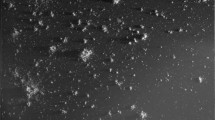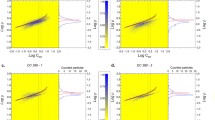Abstract
The highly-skewed diameter and pressure drop distributions of dust devils on Earth and Mars are noted, and challenges of presenting and comparing different types of observations are discussed. The widely-held view that Martian dust devils are larger than Earth’s is critically assessed: the question is confounded somewhat by different observation techniques, but some indication of a \({\sim} 3\mathrm{x}\) larger population on Mars is determined. The largest and most intense (in a relative pressure sense) devils recorded are on Mars, although the largest reported number density is on Earth. The difficulties of concepts used in the literature of ‘average’ diameter, pressure cross section, and area fraction are noted in the context of estimating population-integral effects such as dust lifting.









Similar content being viewed by others
Notes
‘Complete’ in the sense of detecting all devils present in the survey area. Surveys in small areas may statistically encounter less than one devil for large sizes and so are not ‘complete’ in the sense of fully characterizing the population unless they are conducted for a long enough period – see Lorenz (2011). Note that a true power law has no limit, and so there are an infinite number of infinitely small dust devils, which is clearly not the case. In practice there is a lower limit, suggested to be the Obhukhov scale or \({\sim} 1~\mbox{m}\) for typical conditions on Earth.
The Planetary Atmospheres Node of NASA’s Planetary Data System provides support for researchers who wish to archive their dust devil data – http://atmos.nmsu.edu/atmos-home.html.
References
R.E. Arvidson, E.A. Guinness, H.J. Moore, J. Tillman, S.D. Wall, Three Mars years: Viking lander 1 imaging observations. Science 222, 463–468 (1983)
M. Balme, R. Greeley, Dust devils on Earth and Mars. Rev. Geophys. 44(3) (2006). doi:10.1029/2005RG000188
M.R. Balme, P.L. Whelley, R. Greeley, Mars: Dust devil track survey in Argyre Planitia and Hellas Basin. J. Geophys. Res. 108, 5086 (2003). doi:10.1029/2003JE002096
M.R. Balme, A. Pathare, S.M. Metzger, M.C. Towner, S.R. Lewis, A. Spiga, L.K. Fenton, N.O. Renno, H.M. Elliott, F.A. Saca, T.I. Michaels, Field measurements of horizontal forward motion velocities of terrestrial dust devils: towards a proxy for ambient winds on Mars and Earth. Icarus 221(2), 632–645 (2012)
T. Broersen, Quantification of soil erosion by dust devil in the Jordan Badia. MSc thesis, University of Utrecht, The Netherlands (2013)
J.J. Carroll, J.A. Ryan, Atmospheric vorticity and dust devil rotation. J. Geophys. Res. 75(27), 5179–5184 (1970)
M.D. Ellehoj, H.P. Gunnlaugsson, P.A. Taylor, H. Kahanpa, K.M. Bean, B.A. Cantor, B.T. Gheynani, L. Drube, D. Fisher, A.-M. Harri, C. Holstein-Rathlou, M.T. Lemmon, M.B. Madsen, M.C. Malin, J. Polkko, P.H. Smith, L.K. Tamppari, W. Weng, J. Whiteway, Convective vortices and dust devils at the Phoenix Mars mission landing site. J. Geophys. Res. 115, E00E16 (2010)
L. Fenton, R. Lorenz, Dust devil height and spacing with relation to the Martian planetary boundary layer thickness. Icarus 260, 246–262 (2015)
R. Greeley, P.L. Whelley, R.E. Arvidson, N.A. Cabrol, D.J. Foley, B.J. Franklin, P.G. Geissler, M.P. Golombek, R.O. Kuzmin, G.A. Landis, M.T. Lemmon, Active dust devils in Gusev crater, Mars: observations from the Mars Exploration Rover Spirit. J. Geophys. Res., Planets 111(E12) (2006). doi:10.1029/2006JE002743
B.K. Jackson, R.D. Lorenz, A multi-year dust devil vortex survey using an automated search of pressure time-series. J. Geophys. Res., Planets 120 (2015). doi:10.1002/2014JE004712
K.M. Kinch, J. Sohl-Dickstein, J.F. Bell III., J.R. Johnson, W. Goetz, G.A. Landis, Dust deposition on the Mars Exploration Rover Panoramic Camera (Pancam) calibration targets. J. Geophys. Res. 112, E06S03 (2007). doi:10.1029/2006JE002807
M. Klose, B.C. Jemmett-Smith, H. Kahanpaa, M. Kahre, P. Knippertz, M.T. Lemmon, S.R. Lewis, R.D. Lorenz, L.D.V. Neakrase, C. Newman, M.R. Patel, D. Reiss, A. Spiga, P.L. Whelley, Dust devil sediment transport: from lab to field to global impact. Space Sci. Rev. (2016). doi:10.1007/s11214-016-0261-4
J. Koch, N.O. Renno, The role of convective plumes and vortices on the global aerosol budget. Geophys. Res. Lett. 32(18), L18806 (2005)
M.V. Kurgansky, Steady-state properties and statistical distribution of atmospheric dust devils. Geophys. Res. Lett. 33, L19S06 (2006)
M.V. Kurgansky, Statistical distribution of atmospheric dust devils. Icarus 219, 556–560 (2012)
R.L. Lambeth, On the measurement of dust devil parameters. Bull. Am. Meteorol. Soc. 47, 522–526 (1966)
G.A. Landis, P.J. Jenkins, Measurement of the settling rate of atmospheric dust on Mars by the MAE instrument on Mars Pathfinder. J. Geophys. Res. 105, 1855–1857 (2000)
R.D. Lorenz, Power law of dust devils on Earth and Mars. Icarus 203, 683–684 (2009)
R.D. Lorenz, Studies of desert dust devils with a sensor network, timelapse cameras and thermal imaging, in Aerospace Conference, 6 March 2010 (IEEE Press, New York, 2010), pp. 1–7
R.D. Lorenz, On the statistical distribution of dust devil diameters. Icarus 215, 381–390 (2011)
R.D. Lorenz, Pressure drops in dust devils: Earth and Mars. Planet. Space Sci. 60, 370–375 (2012)
R.D. Lorenz, The longevity and aspect ratio of dust devils: effects on detection efficiencies and comparison of landed and orbital imaging at Mars. Icarus 226, 964–970 (2013)
R.D. Lorenz, Vortex encounter rates with fixed barometer stations: comparison with visual dust devil counts and large eddy simulations. J. Atmos. Sci. 71, 4461–4472 (2014)
R.D. Lorenz, D. Christie, Dust devil signatures in infrasound records of the international monitoring system. Geophys. Res. Lett. 42, 2009–2014 (2015). doi:10.1002/2015GL063237
R.D. Lorenz, B.K. Jackson, Dust devils and dustless vortices on a desert playa observed with surface pressure and solar flux logging. J. Geophys. Res. 5, 1 (2015)
R.D. Lorenz, P.D. Lanagan, A barometric survey of dust devil vortices on a Desert Playa. Bound.-Layer Meteorol. 53, 555–568 (2014). doi:10.1007/s10546-014-9954-y
R. Lorenz, J. Radebaugh, Dust devils in thin air: vortex observations at a high elevation Mars analog site in the Argentinian Puna. Geophys. Res. Lett. (2016). doi:10.1002/2015GL067412
R.D. Lorenz, D. Reiss, Solar panel clearing events, dust devil tracks, and in-situ vortex detections on Mars. Icarus 248, 162–164 (2015)
R.D. Lorenz, J. Zimbelman, Dune Worlds: How Wind-Blown Sand Shapes Planetary Landscapes (Springer, Berlin, 2014)
R.D. Lorenz, M.R. Balme, Z. Gu, H. Kahanpää, M. Klose, M. Kurgansky, M.R. Patel, D. Reiss, A.P. Rossi, A. Spiga, T. Takemi, W. Wei, History and applications of dust devil studies. Space Sci. Rev. (2016). doi:10.1007/s11214-016-0239-2
J.P. Mason, M.R. Patel, S.R. Lewis, Radiative transfer modelling of dust devils. Icarus 223(1), 1 (2013)
J.O. Mattsson, T. Nihlén, W. Yue, Observations of dust devils in a semi-arid district of southern Tunisia. Weather 48(11), 359–363 (1993)
H.J. Melosh, Impact Cratering: A Geologic Process (Oxford Univ. Press, London, 1990)
S. Metzger, M. Balme, A. Pathare, Meteorologic conditions and the formation of terrestrial dust devils, in 40th Lunar and Planetary Science Conference, Houston, TX (2009)
J.E. Moores, M.T. Lemmon, H. Kahanpää, S.C. Rafkin, R. Francis, J. Pla-Garcia, K. Bean, R. Haberle, C. Newman, M. Mischna, A.R. Vasavada, Observational evidence of a suppressed planetary boundary layer in northern Gale Crater, Mars as seen by the Navcam instrument onboard the Mars Science Laboratory rover. Icarus 249, 129–142 (2015)
J.R. Murphy, S. Nelli, Mars pathfinder convective vortices: frequency of occurrence. Geophys. Res. Lett. 29(23) (2002). doi:10.1029/2002GL015214
L.D.V. Neakrase, R. Greeley, J.D. Iversen, M.R. Balme, E.E. Eddlemon, Dust flux within dust devils: preliminary laboratory simulations. Geophys. Res. Lett. 33, L19S09 (2006). doi:10.1029/2006GL026810
H. Ohno, T. Takemi, Mechanisms for intensification and maintenance of numerically simulated dust devils. Atmos. Sci. Lett. 11, 27–32 (2010). doi:10.1002/asl.249
A.M.C. Oke, N.J. Tapper, D. Dunkerley, Willy-willies in the Australian landscape: the role of key meteorological variables and surface conditions in defining frequency and spatial characteristics. J. Arid Environ. 71, 201–215 (2007)
A.V. Pathare, M.R. Balme, S.M. Metzger, A. Spiga, M.C. Towner, N.O. Renno, F. Saca, Assessing the power law hypothesis for the size-frequency distribution of terrestrial and martian dust devils. Icarus 209, 851–852 (2010)
S. Raasch, T. Franke, Structure and formation of dust devil-like vortices in the atmospheric boundary layer: a high-resolution numerical study. J. Geophys. Res., Atmos. 116(D16) (2011). doi:10.1029/2011JD016010
D. Reiss, First observations of terrestrial dust devils in orbital image data: comparison with dust devils in Amazonis Planitia, Mars, in Lunar and Planetary Science Conference, Houston, TX, 21–25 March (2016)
D. Reiss, A. Spiga, G. Erkeling, The horizontal motion of dust devils on Mars derived from CRISM and CTX/HiRISE observations. Icarus 227, 8–20 (2014)
D. Reiss, L. Fenton, L. Neakrase, M. Zimmerman, T. Statella, P. Whelley, A.P. Rossi, M. Balme, Dust devil tracks. Space Sci. Rev. (2016 this issue)
T.J. Ringrose, M.C. Towner, J.C. Zarnecki, Convective vortices on Mars: a reanalysis of Viking Lander 2 meteorological data, sols 1–60. Icarus 163, 78–87 (2003)
T.J. Ringrose, M.R. Patel, M.C. Towner, M. Balme, S.M. Metzger, J.C. Zarnecki, The meteorological signatures of dust devils on Mars. Planet. Space Sci. 55 (14), 2151–2163 (2007)
J.A. Ryan, J.J. Carroll, Dust devil wind velocities: mature state. J. Geophys. Res. 75, 531–541 (1970)
J.A. Ryan, R.D. Lucich, Possible dust devils, vortices on Mars. J. Geophys. Res. 88, 11005–11011 (1983)
J. Scargle, J. Norris, B. Jackson, J. Chiang, Studies in astronomical time series analysis, VI: Bayesian block representations. Astrophys. J. 764(2), 167 (2013). doi:10.1088/0004-637X/764/2/167
P.C. Sinclair, General characteristics of dust devils. J. Appl. Meteorol. 8(1), 32–45 (1969)
P.C. Sinclair, The lower structure of dust devils. J. Atmos. Sci. 30(8), 1599–1619 (1973)
J.T. Snow, T. McClelland, Dust devils at White Sands Missile Range, New Mexico, 1: temporal and spatial distributions. J. Geophys. Res. 95, 13,707–13,721 (1990)
C. Stanzel, M. Pätzold, D.A. Williams, P.L. Whelley, R. Greeley, G. Neukum (HRSC Co-Investigator Team), Dust devil speeds, directions of motion and general characteristics observed by the Mars Express High Resolution Stereo Camera. Icarus 197(1), 39–51 (2008)
D.M. Tratt, M.H. Hecht, D.C. Catling, E.C. Samulon, P.H. Smith, In situ measurements of dust devil dynamics: toward a strategy for Mars. J. Geophys. Res. 108(E11), 5116 (2003). doi:10.1029/2003JE002161
C.A. Verba, P. Geissler, T. Titus, D. Waller, Observations from the High Resolution Imaging Science Experiment (HiRISE): martian dust devils in Gusev and Russell craters. J. Geophys. Res. 115, E09002 (2012). doi:10.1029/2009JE003498
R.E. Wyett, Pressure drop in a dust devil. Mon. Weather Rev. 82, 7 (1954)
Author information
Authors and Affiliations
Corresponding author
Rights and permissions
About this article
Cite this article
Lorenz, R.D., Jackson, B.K. Dust Devil Populations and Statistics. Space Sci Rev 203, 277–297 (2016). https://doi.org/10.1007/s11214-016-0277-9
Received:
Accepted:
Published:
Issue Date:
DOI: https://doi.org/10.1007/s11214-016-0277-9




